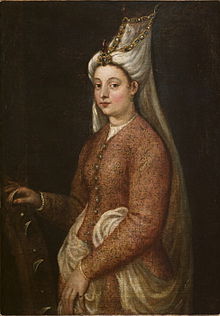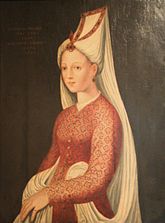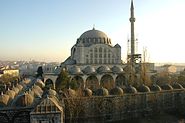- Mihrimah Sultan
-
Daughter of Suleiman the Magnificent and Roxelana
The Princess Mihrimah Sultan
Potraid by TitianBorn 1522
Constantinople / Istanbul, Ottoman EmpireDied 25 January 1578
Constantinople / IstanbulResting place Süleymaniye Mosque, Constantinople / Istanbul Known for Princess Religion Islam Spouse Damat Rüstem Pasha Princess Mihrimah Sultan (born 21 March 1522 – 25 January 1578) was the daughter of Suleiman I, ruler of the Ottoman Empire, from his fourth Ruthenian wife, (1558) Hürrem Sultan. Princess Mihrimah's name is also spelled Mirhumah, Mihr-î-Mâh, Mihrî-a-Mâh or Mehr-î-Mâh. She was born in İstanbul. Mehr-î-Mâh means "Sun (lit. clemency, compassion, endearment, affection) and Moon".
Biography
Mihrimah traveled throughout the Ottoman Empire with her father as he surveyed the lands and conquered new ones. It is written in Persian literature that she traveled into battle with her father on an Arabian stallion called Batal at the Battle of Gizah in northern Egypt outside Alexandria.
In Istanbul on 26 November, 1539, at the age of seventeen, Mihr-î-Mâh was married off to Damat (literal translation, son-in-law) Rüstem Pasha (1505 -10 July, 1561), the Grand Vizier under Suleiman. Though the union was unhappy, Mihrimah flourished as a patroness of the arts and continued her travels with her father until her husband's death.
The fact that Mihrimah encouraged her father to launch the campaign against Malta, promising to build 400 galleys at her own expense; that like her mother she wrote letters to Sigismund II the King of Poland; and that on her father's death she lent 50,000 gold sovereigns to her brother Sultan Selim to meet his immediate needs, illustrate the political power which she wielded.
She was not only a princess, but functioned as Valide Sultan (equivalent to "Queen Mother") to her younger brother Selim II (r. 1566 - 1574). In Ottoman Turkey, the valide sultan traditionally had access to considerable economic resources and often funded major architectural projects. Mihrimah Sultan's most famous foundations are the two Istanbul-area mosque complexes that bear her name, both designed by her father's chief architect, Mimar Sinan. Mihrimah Mosque at the Edirne Gate, at the western wall of the old city of Istanbul, was one of Sinan's most imaginative designs, using new support systems and lateral spaces to increase the area available for windows. The second mosque is the İskele Mosque, which is one of Üsküdar's most prominent landmarks. There is a myth about these two Mosques. It is said that Mimar Sinan fell in love with Mihrimah and built the smaller mosque in Edirnekapı without palace approval, on his own, dedicated to his love. The legend continues to say that on 21st of March (when day time and night time are equal and Mihrimah's alleged birthday, hence the name) at the time of sunset, if you have clear view of both mosques, you will notice that as the sun sets behind the only minaret of the mosque in Edirnekapı, the moon rises between the two minarets of the mosque in Üsküdar.
She died in Istanbul on 25 January 1578.
References
- Imperial Harem : Women and Sovereignty in the Ottoman Empire 1993 by Leslie Peirce, Oxford University Press, ISBN 0-19-508677-5.
- See Sinan http://en.wikipedia.org/wiki/Mimar_Sinan
External links
- Photos of Mihrimah Sultan Mosque in Edirnekapi
- Photos of Iskele Mosque (aka Mihrimah) in Uskudar
- Mihrimah Sultan Mosque in Edirnekapi
- Mihrimah Sultan -- an Ottoman princess’ legacy survives
Princess Mihrimah Sultan • Kaya Sultan • Princess Hatice Sultan • Hatice Sultan (1766–1821) • Esma Sultan (1778–1848) • Adile Sultana • Esma Sultana (1873–1899) • Fehime SultanCategories:- 1522 births
- 1578 deaths
- Women of the Ottoman Empire
- Ottoman women in warfare
- Ottoman people of Ukrainian descent
Wikimedia Foundation. 2010.



